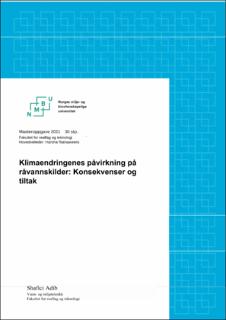| dc.contributor.advisor | Ratnaweera, Harsha Chandima | |
| dc.contributor.author | Adib, Shafici Hussein | |
| dc.date.accessioned | 2021-11-22T14:04:54Z | |
| dc.date.available | 2021-11-22T14:04:54Z | |
| dc.date.issued | 2021 | |
| dc.identifier.uri | https://hdl.handle.net/11250/2830748 | |
| dc.description.abstract | Klimaendringene har allerede påført verden observerbare endringer. Økningen i omfang og hyppighet av ekstremnedbørhendelser blir observert over store deler av verden. Man ser denne problematikken i Norge også, og i fremtiden vil problemene knyttet til økt nedbørsmengde og temperatur gi problemer til vannforsyningen i Norge. For å forbedre oss på fremtiden er det viktig å legge til rette for vurdering og planlegging av systemer for klimatilpasning i vannforsyningen, og samt er det derfor viktig at dagens løsninger utformes for fremtidig klima og vannmengder.
Det overordnede målet med oppgaven er å rette oppmerksomhet mot et tema som er lite undersøkt i norsk sammenheng, og vil påvirke våre liv i et stort skala i fremtiden. Jeg ønsker å bidra til at diverse aktører kan få en bevissthet om utfordringene som er knyttet til et klima som er i endring, øke kunnskapen om eventuelle utfordringer på vannforsyningen og forebyggende tiltak andre land har brukt.
Vannforsyning er en kritisk infrastruktur og tjeneste som er berør av klimaendringene. Det er viktig å utrede hvordan klimaendringer påvirker norske råvannsresurser og hvordan Norge kan imøtekomme disse utfordringene. Denne oppgaven setter derfor søkelys på problemstillinger tilknyttet dette for å belyse overnevnte tema.
Funnene i litteraturen påpekte at nedbørsrike perioder medfører høyere fargetall i råvannskilder, eksempelvis i Norge var det i tilfeller fordobling av fargetall ved nedbørsrike perioder, samt betraktelig økning i partikler etter flom. Økt innhold av organisk materiale vil redusere råvannskvaliteten, samt man vil man få en økning i antall patogene mikroorganismer ved høyere temperatur og dette kan medføre sykdomsutbrudd ved ikke tilstrekkelig vannbehandling.
Det blir sett på hvordan Norge kan hente kunnskap fra andre europeiske land, som eksempelvis nabolandene Sverige og Finland i deres planer, tiltak og strategier for å motvirke påvirkningene klimaendringene har på vannforsyningen | en_US |
| dc.description.abstract | The ongoing climate crisis has caused irrefutable changes in the contemporary world. There has been reported an increase in not only the quantity of observations in occurrences of extreme temperatures and increased precipitation across the globe. However, there is also the widespread nature of these incidents to consider. The challenges this brings are apparent in Norway as well. In the future, challenges related to increased precipitation and temperatures will cause complications for Norway’s water supplies. In preparation, it is vital to facilitate the proper means for the assessment and organization for systems of climate adaptation in our water supplies, which is why it is crucial that we have the future climate and water resources in mind, when we design today’s solutions.
The water supply industry is a crucial infrastructure and service which has been affected by climate change. It is with great importance that it is examined how climate changes will impact Norwegian water resources, and how Norway can encounter these challenges.
The overall objective of this paper is directing a conversation surrounding a theme, which has not been given the proper attention or exploration it needs in Norway, as it is a matter that will affect us on an even bigger scale in the future. With this thesis as my contribution, I wish to raise awareness directed towards the various challenges an altered environment brings. Furthermore, with this thesis, I would like to partake in the assisting of giving an understanding of possible future issues within the water industry and what interventions other nations have taken to, regarding these issues.
The research I have studied connected to this theme, noted that periods with abundant precipitation results in higher color-coded numbers in natural water resources. For instance, in Norway, there were occurrences in which the color-coded numbers had a doubled increase during abundant precipitation periods. There was also an increase in particles after floods as well. An increase in organic material will result in a decrease in quality of the water source, whilst there will also be an increase in pathogenic microorganisms during higher temperatures. It will also be shown a study of documents from five European nations to demonstrate if other nations are a step ahead, and if Norway can be able to draw knowledge from other European countries, ,in their planned measures and their strategies for how to counteract the effects climate change has on the water supply. | en_US |
| dc.language.iso | nob | en_US |
| dc.publisher | Norwegian University of Life Sciences, Ås | en_US |
| dc.rights | Attribution-NonCommercial-NoDerivatives 4.0 Internasjonal | * |
| dc.rights.uri | http://creativecommons.org/licenses/by-nc-nd/4.0/deed.no | * |
| dc.title | Klimaendringenes påvirkning på råvannskilder : konsekvenser og tiltak | en_US |
| dc.type | Master thesis | en_US |
| dc.description.localcode | M-VM | en_US |

